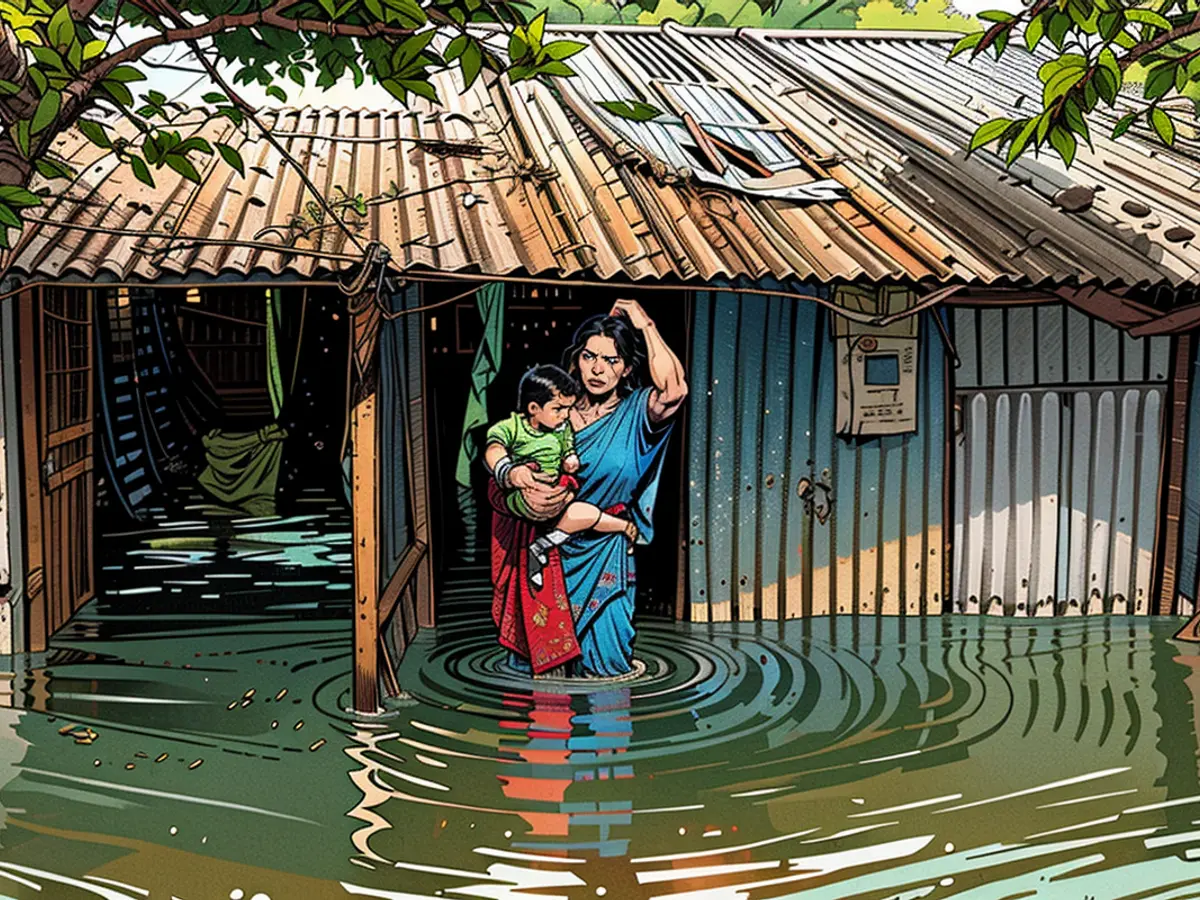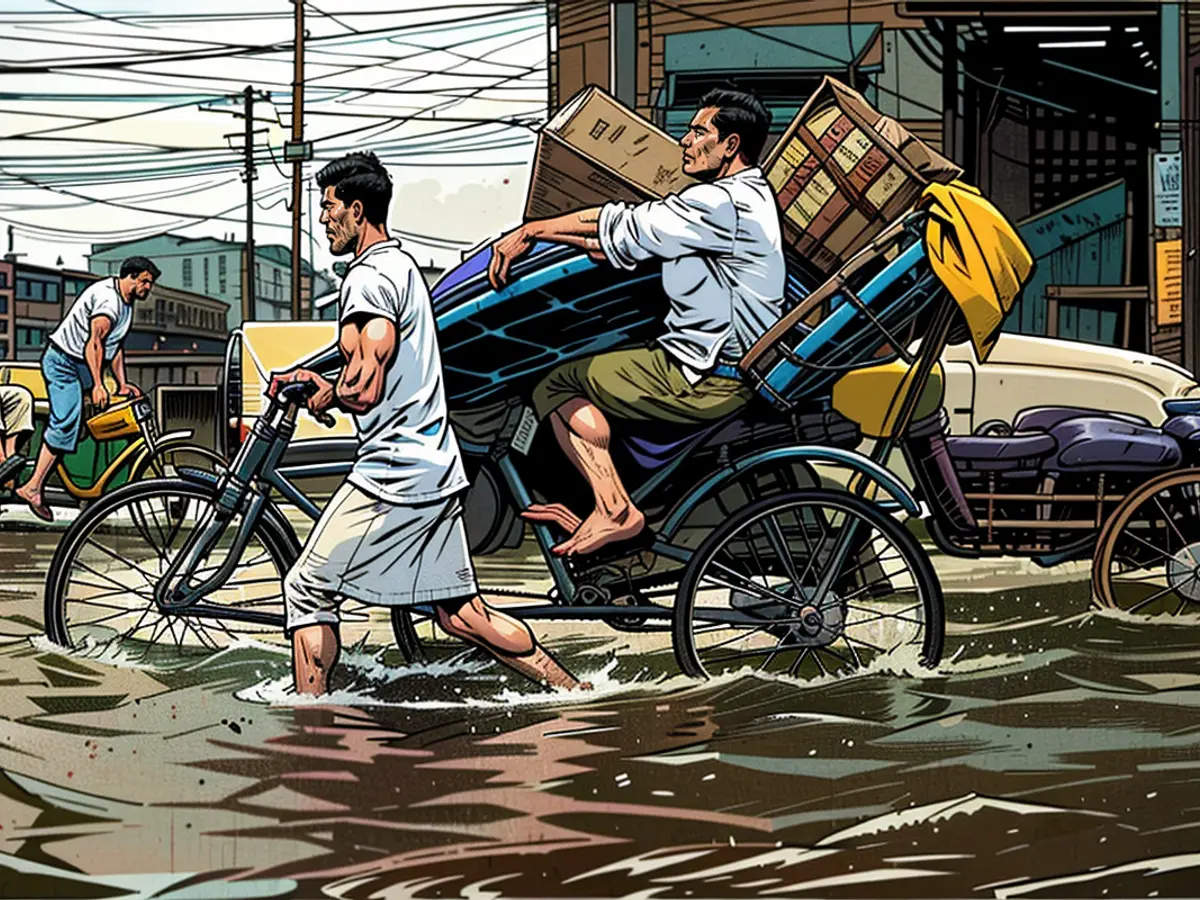catastrophic floods strike Bangladesh once more, leaving almost 2 million individuals in distress and stranded within barely a month's span.
Flooding of vast areas in Sylhet city and Sunamganj town is depicted in a video, as reported by Bangladesh Sangbad Sangstha (BSS) on Saturday. The widespread flooding was caused by persistent heavy rain and overflowing of rivers due to water runoff from the hilly regions along the border with India.
According to the Water Development Board, four rivers surpassed their danger marks due to the excessive rain and runoff, as previously reported in local media.
Images show villagers in the severely affected low-lying areas of Sylhet wading through water waist-deep and stacking their belongings to protect them from the filthy waters.
There is concern for those trapped by the floodwaters, who now face food scarcity and a lack of clean water, according to local reports.
Approximately 1.75 million people in Sylhet and 792,000 in Sunamganj have been affected by the flooding, with authorities creating over 6,000 shelters to assist the displaced, as reported by BSS.
Among them are 772,000 children in urgent need of assistance, according to the United Nations’ Children’s Fund (UNICEF), who reported that more than 800 schools had been flooded, with an additional 500 used as flood shelters.
"As waters rise, children are the most vulnerable, facing increased risks of drowning, malnutrition, waterborne diseases, displacement trauma, and potential abuse in overcrowded shelters," Sheldon Yett, UNICEF Representative to Bangladesh, said in a statement.
Densely populated and low-lying Bangladesh is prone to rain, flooding, and cyclones. However, the country is considered one of the most vulnerable to the impacts of the human-induced climate crisis, as evidenced by studies. As extreme weather events become more frequent and severe due to the climate crisis, the humanitarian and economic consequences for Bangladesh will worsen.
By 2050, 13 million people in Bangladesh could become climate migrants, and severe flooding could cause the GDP to decline by as much as 9%, according to the World Bank.
The recent downpours and floods occurred soon after the region recuperated from widespread flooding in late May following Tropical Cyclone Remal, which affected about 5 million people in Bangladesh and southern India.
"For many, this will change the course of their lives, leaving them without homes and schools and forcing them to move to temporary shelters for an undetermined period," said Sultana Begum, Save the Children’s regional humanitarian advocacy and policy manager for Asia, in a statement.
"Everything we are hearing points towards these kinds of extreme weather events becoming increasingly severe. And we have not seen two bouts of severe flooding occur so quickly before. Make no mistake, the climate emergency is already making its mark on India and Bangladesh, and it is taking away children's homes, families, food, water, and access to education and healthcare."
Rohingya at risk

Monsoon rains and landslides affect southern Bangladesh, where around a million Rohingya Muslims live in the world's largest refugee camps, having fled persecution and violence in neighboring Myanmar.
At least 10 people, including three children, died from mudslides and heavy rainfall in the refugee camps near Cox's Bazar on Wednesday, according to Bangladesh's Ministry of Disaster Management and Relief.
"People have been evacuated from low-lying areas, and at least 500 people have been shifted to other relief centers," Hasan Sarwar, head of the refugee cell for the ministry, told CNN last week.
Many Rohingya refugees reside in makeshift shelters made of bamboo and tarpaulin on hillside slopes that are susceptible to strong winds, rain, and landslides.
Save the Children reported that about 8,000 people in 33 camps have been impacted by the torrential downpours, which have damaged or destroyed more than 1,000 shelters.
The monsoon season in Bangladesh has just begun and will last for the next two months, potentially bringing more heavy rains, landslides, and flooding.
Landslides, heavy rains, and flooding have also affected the neighboring Indian state of Assam, affecting more than 4 million people, according to Save the Children.
At least 31 people have died in the floods and landslides since May 29 in the state, according to local police and disaster management authorities.
Some relief for northeast Bangladesh may be on the horizon, as the rains have started to diminish and floodwaters are reportedly receding, according to local media.
The Bangladesh Water Development Board stated Saturday that water levels of the major rivers in the northeast were falling and the trend could continue in the coming days if further rain remains at bay.
"Overall improvement of the flood situation in various low-lying areas under districts of the northeastern part of the country may continue in the next 72 hours," it said.

Read also:
The flooding in Sylhet city and Sunamganj town has also impacted the Rohingya refugees living in southern Bangladesh, who are susceptible to landslides and floods due to their makeshift shelters.
Despite being one of the most vulnerable countries to climate change effects, Bangladesh has been experiencing repeated severe floods, increasing concerns about the future of its people and economy.







